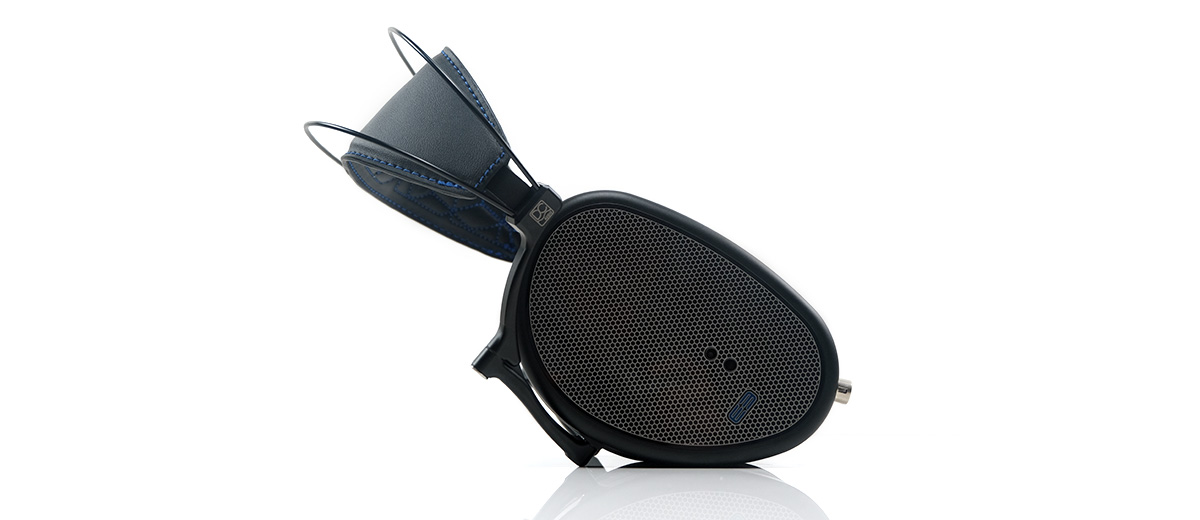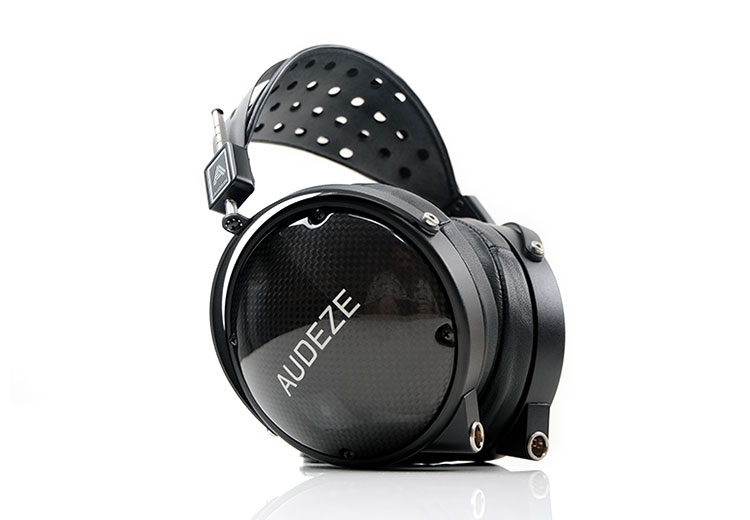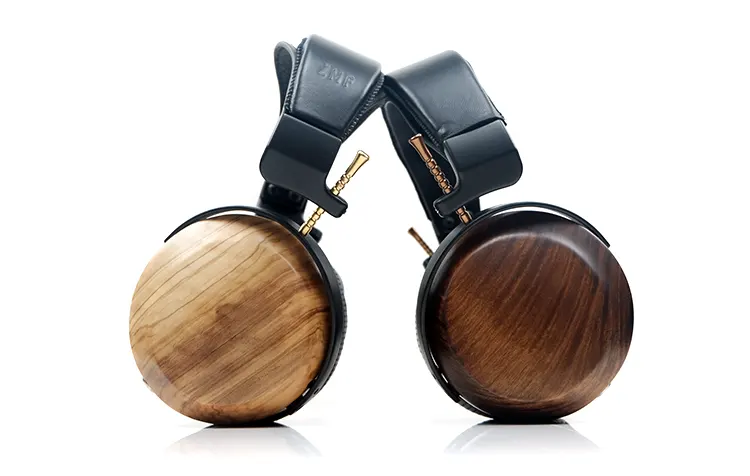Select Comparisons
For our E3 select comparisons, we decided to go with competing models in and around a similar price point. There are plenty of comparison mentions of the Stealth and AEON 2 Noire in the review thus far for those interested.
Testing was completed using a Ferrum OOR/HYPSOS stack along with a Holo Audio Spring 2 Wildism Edition DAC and Cayin’s N8ii DAP.
Audeze LCD-XC 2021
The Audeze LCD-XC was launched in 2021, (funnily enough), with some significant upgrades over the original XC model. Our review of the LCD-XC 2021 came out in the middle of that same year.
Technical
In a way, both of these closed-back planar headphones’ internals are evolutionary rather than brand new thinking from the ground up.
For the E3, the AMTS technology is already there in the Stealth, EXPANSE, and Corina as is the V-Planar driver technology in the first two.
Whereas Audeze has used Fazor for a wide range of their line-up before and after. Also, the same 106mm Ultra-Thin 106mm diameter planar diaphragm was already in the original XC way back in 2014.
Arguably, though the LCD-XC-2021 is an update, albeit extensive, of what has come before. The tweaks included stacking the N50 magnets instead of staggered and reducing the Fazor count from 8 to 6 ‘windows’. There is also some new memory foam in the pads and a slight lift in the pad ring for driver venting.
Whereas the E3 is an entirely new closed-back headphone with a unique version of AMTS specifically for this launch and an upgraded diaphragm material to go along with it. There are degrees of evolution here and the E3 is the more ambitious of the two on paper.
Both headphones do not have any serious load concerns at 20Ω for the LCD-XC and 27Ω for the E3. Where the difference is in the SPL rating with the E3 less sensitive at -90 dB/mW compared to the LCD-XC’s -100 dB/1mW. You will need a bit more volume for the E3 to hit satisfactory listening levels.
Design
The LCD-XC has a muscular aesthetic with traditional round cups and a headline weight of 677g. It is by far the heavier and bulkier of the two headphones and to be frank the E3 is the king of comfort at just 455g.
To be fair, despite the additional weight the LCD-XC 2021 does quite well in terms of pressure distribution combined with those soft plush, and very thick leather pads. The internal pad openings are roomy enough to fit most ears and any overt clamping is mitigated by how malleable the pad’s contact surface is.
The E3 is perhaps the more modern of the two visually with the innovative use of Gorilla Glass on the ovoid cups combined with its unique folding capability that converts them into a very compact entity for transport.
The LCD-XC 2021 form factor remains as is for transportation so it is less transportable in a sense but it does come with those dashing travel cases that keep them very secure and safe.
I am agnostic on the cable quality between these two. The E3 stock VIVO cable is bulkier and though Hirose is a known standard it is less widely used compared to mini-XLR.
However, 1.9m 20AWG high-purity OCC copper wire LCD-XC 2021 cable only ships with 6.35mm SE as standard whereas with the VIVO you can choose a wider range of lengths and jack terminations making amplifier matching a bit easier.
Performance
The LCD-XC 2021 is all about the snap, speed, and clarity. Tonally, it is neutral to slightly bright with a flatter bass response and an aggressive upfront vocal presence with plenty of 5-8k sparkle.
By contrast, the E3 sounds the more relaxed of the two with more sub-bass presence, a slightly warmer and less aggressive vocal imaging experience, and a 5-8k treble tuning, that though energetic, is not as dominant as the LCD-XC 2021 equivalent.
The LCD-XC 2021 clarity is excellent but the staging presentation is going to play strongly to the mids with higher pitching percussion staging at the same level and perhaps pitching out wider than the E3’s equivalent.
From 800Hz up to 3K the LCD-XC 2021 FR is generally more amplified to give that strong vocal first presentation. The E3 is about 2-3 dB calmer across the same region pulling more warmth from the plumper lows giving it a richer tonal quality but also one that sits a little further back imaging-wise.
Not too far back but rather a positioning that sounds more natural to my ear and perhaps over time in a listening session a little less fatiguing.
Because of the LCD-XC 2021’s vivid 5-8k treble tuning, some instruments will ring a little louder or have a bit more shine to them. I can still hear them clearly on the E3 but they have a comparatively softer tone and a gentler presentation and don’t stick out as much.
Guitar string picks, tambourine smacks, and triangles offer more bite and a strong presence with the LCD-XC 2021. Whereas on the E3 the same notes are not as dominant with the attack and decay breaking and falling way in a smoother subtler manner.
Meze Audio Liric
The Meze Audio Liric was launched late in 2021 with its SRP priced fairly close to the E3. It also won our Top Gear Best Closed Back Headphones of that same year. You can read our full review of the Liric here.
Technical
Both headphones are closed-back planar headphones with a strong in-house principle in terms of driver technology. The Liric sticks to Meze’s Isodynamic hybrid array design whereas DCA is on its 5th gen V-Planar driver combined with its AMTS technology.
The Liric MZ4 planar driver is new but it’s more of a scaled-down version closer in its origins to the Empyrean MZ3 driver’s switchback and spiral-shaped voice coils with the addition of a new Phase-X™ system. It also seems to be physically smaller than the E3 version with an active surface area of 3507mm².
In some respects, Phase-X has some shared commonality with AMTS being designed to target traditional closed-back acoustical issues such as imaging accuracy, distortion, and perceived staging size.
AMTS, however, goes a lot further with its programmable capability for actually shaping the FR itself, with specific reference to a programmable Helmholtz or quarter-wave resonator to control high-frequency standing waves and resonance.
At -90 dB/mW, the E3 is harder to drive compared to the Liric which is rated at 100 dB/mW SPL. That should make the Liric a bit more portable and player-friendly. The E3 needs an amp with decent power though some of the more powerful portable devices such as the FiiO M17 with its DC power mode will juice it quite well.
Design
Meze and DCA are two companies that I believe have nailed how to make attractive-looking headphones that are also very comfortable. The E3 and Liric are no exception to that statement.
However, the Liric is the smaller of the two headphones when the E3 is fully extended, and as such it feels more like a large supraaural cup design with the pads partially resting on your ear. The E3’s large ovoid cups clear your ears making it more of a classic circumaural wearing experience.
Since it is smaller, the Liric is lighter but not by a huge amount at 391g compared to 455g. It is enough to notice a bit of a weight difference when wearing them but I would argue that the Liric’s shape and pad sizing dominate the wearing experience more than the weight difference. The comfort levels are otherwise very even between them.
Both of these headphones have porting systems on the side of the cups but for isolation, the Liric does better. Perhaps a slightly stronger clamp on the sides with non-perforated leather padding is a factor alongside a less open porting system.
The aesthetics are strong for both. The Liric borrows a lot of the Empyrean visuals but is scaled down a bit and slightly simplified too. Still, the black ovoid cup shape accented with those distinctive arched gimbals and copper-coated aluminum headband adjusting rods is very attractive.
The E3 might have an edge on the complexity of the aesthetics since the Liric has a blander cup finish but it’s that folding capability of the E3 that sets these two apart for daily use and transportation.
Performance
Bigger headphones bigger sound in a nutshell. The E3 not only delivers a bigger soundstage but also a more immersive one. The layering and complexity of the imaging are more intricate and at times more resolving when compared to the Liric which falls short in terms of staging width.
That Liric does have some solid pros though. Its depth and body on the lows are strong, perhaps one of its best assets giving it more weight and bloom and overall, something that EDM lovers will find endearing. The E3 has some nice low-end extension also and whilst not as fulsome it is perhaps snappier and punchier.
Where the E3 excels compared to the Liric lows is the space and layering and the level of detail in the texture of those notes. Also, that 200-500Hz cut on the Liric FR can sound somewhat abrupt and unnatural compared to the smoother drop into the lower mids on the E3.
The E3 also rolls ahead for treble reproduction once you switch away from safer EDM and R’n’B territory. High-pitched percussion and synth timbre sound very clean but also lighter than the E3 and harder-edged.
Much of that comes from an upper treble push from 8-10k which bumps the Liric’s upper-order harmonics. Snares have a lot of bite, and natural sibilance can be heard with a bit of steeliness in the coloration.
The E3 has some sparkle up top but the tonal quality is much more natural for percussion and some vocal harmonics. There is less of a zing to its upper mids and treble for rock and metal percussion.
ZMF Headphones Atrium Closed
The ZMF Headphones Atrium Closed was launched in early 2023 with our review around the same time. It also won our Top Gear Best Closed Headphones for 2023. You can read our full review of the Atrium Closed here. Note we are comparing the Olivewood Limited Edition unit in this review.
Technical
Despite both being closed-backs circumaural headphones we have very different internals here.
The Atrium Closed uses a 50mm bio-cellulose diaphragm dynamic driver surrounded by N52 rare earth neodymium magnets as opposed to the E3’s 5th gen V-planar driver combined with a unique new configuration of AMTS.
Not to mention their driving requirements are quite different also with the Atrium Closed rated at 300Ω which generally plays out better on voltage-friendly OTL or modern SETA tube amplifiers despite volume rarely being an issue on weaker voltage DAPs.
The E3, on the other hand, has no such load issues being a planar headphone but at -90 dB / mW, its SPL is far less sensitive compared to the Atrium Closed. You will find yourself pushing up the volume dial a lot more with the E3.
They do have one common ground though with the Atrium damping system used in the Closed doing some of the things the E3 AMTS does.
Not only is the Atrium damping system technology similarly malleable to suit the specific headphone but it also is designed to eliminate the potential for standing sound waves through gradual diffusion.
Design
ZMF makes some beautiful headphones and there is a very attractive, artisanal feel to the uniquely grained cups when in the hand. Especially the Olivewood edition with its strong grain patterns and lighter wood tones.
In some ways, the E3 is engineered with more nuanced complexity with its stronger emphasis on minimizing weight and especially size with that folding structure. However, the color choices, at least from afar, make it a lower-profile visual affair.
The Atrium Closed is the heavier and bulkier of the two headphones at just under 500g. The padding combined with the headband structure and pressure displacement makes the Atrium Closed a fairly comfortable headphone to wear for extended periods but it’s nowhere near as comfortable as the E3 in general.
Both of these headphones have fairly aggressive venting systems for closed-back designs so neither has a distinct advantage in terms of isolation. Perhaps a very slight edge to the Atrium Closed courtesy of a stronger clamp.
ZMF does place a lot of stock in their replaceable pads and they are a little bit easier to replace than the E3 ones, but only just. You get two sets of pads, the ZMF Caldera thin (Lamb) and Caldera Suede pads, and they do affect the performance of the headphones.
DCA has stopped going with the filter pads that were their stock in trade with the older Ether line. They now place more emphasis on the AMTS tuning but there is some discussion on positioning having a nuanced effect on the E3’s performance.
The back or top of your ear closer to the top and rear of the ear pad should smoothen the sound whereas centering the cups on your ear canal will bring more treble back into play.
Performance
This is like comparing apples to oranges in some respects with the V-shaped, (‘ish), dynamic driver slam of the Atrium Closed Olivewood more of a complementary headphone to the E3’s more Harman-centric tuning.
I will say though on a macro level, the Atrium Closed has a pretty large arena-like quality to its soundstage. The E3 can sound taller but not as cavernous with a little trimmed off the sides and back so to speak.
What the E3 excels at though is the turn of pace with better clarity through the mids. For me, it is the more resolving of the two headphones. The Atrium Closed dips throughout the mids to around 2k and that tends to mask some detail and rob instruments and vocals of presence and clarity when the bass goes into overdrive.
It is the complete opposite for the E3 where mids are to the fore, with better imaging and excellent vocal presence. If you need a headphone that can handle midrange complexity was more ease and confidence then the E3 is the better choice.
Where the E3 perhaps cannot compete is in the low-end slam and power the Atrium Closed can generate. Is the E3 bass tighter and better defined? Yes. Does it offer improved layering? Yes. But for power and punch, the Atrium Closed Olivewood LTD has a definite edge.
Our Verdict
The Dan Clark Audio E3 is as close to closed-back planar audio nirvana as you can get right now and I include the Stealth in that statement given the price difference.
It is more spacious sounding than any regular closed-back planar combined with a dynamic tuning that provides a lot of ‘joy’ for everyday listening. It’s a lively sound but importantly one that sounds quite different from the smoother more natural tone of the Stealth.
There will be fans of both sound signatures and perhaps those who will want to own both. So, my finishing thoughts are aimed squarely at the AEON 2 Noire owners who are looking for the next step up.
The E3 is the more natural choice for your next upgrade. It will not cost the ends of the earth nor require a ‘nuclear plant’ to drive it either. It is also sleeker-looking and as comfortable on the head as you can expect from a folding DCA creation. Importantly, it’s a headphone that I feel sure James Hetfield will also thank you for using.
Dan Clark Audio E3 Technical Specifications
- Weight. 455g
- Impedance. 27Ω
- Sensitivity. -90 dB/mW
- Distortion. < 0.1% ref 80dB White Noise






